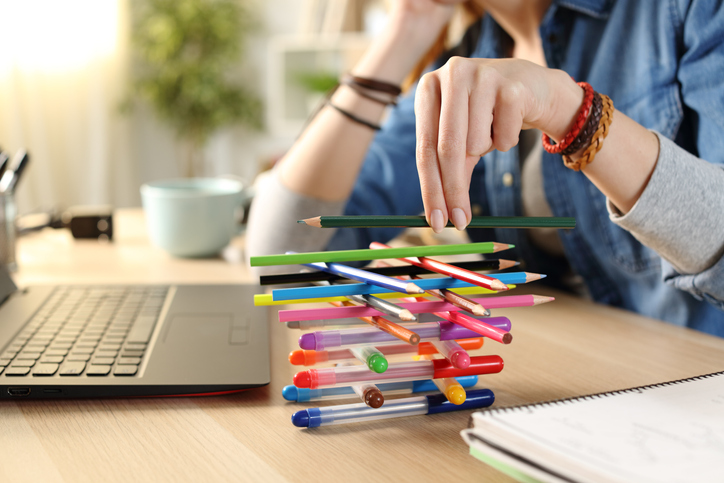 Many people with ADHD think that procrastination is a natural part of having ADHD and, all too often, see themselves as being incapable of getting things done that they would like to. However, most procrastinators rarely spend their time doing nothing. Instead, they are great at doing other things–sharpening pencils, picking the right music to listen to, tidying up the kitchen, etc.: anything but the main task. It seems that people with ADHD who procrastinate can be productive, as long as they’re focusing on a task that interests them and isn’t too challenging. When people engage in more interesting and approachable tasks, while putting off a more important task that might seem overwhelming, it’s known as productive procrastination.
Many people with ADHD think that procrastination is a natural part of having ADHD and, all too often, see themselves as being incapable of getting things done that they would like to. However, most procrastinators rarely spend their time doing nothing. Instead, they are great at doing other things–sharpening pencils, picking the right music to listen to, tidying up the kitchen, etc.: anything but the main task. It seems that people with ADHD who procrastinate can be productive, as long as they’re focusing on a task that interests them and isn’t too challenging. When people engage in more interesting and approachable tasks, while putting off a more important task that might seem overwhelming, it’s known as productive procrastination.
Procrastination, ADHD and anxiety
Procrastination can be debilitating. Your child with ADHD puts off her science project until the day before it’s due; you wait to clean your house until an hour before your in-laws arrive when your panic about having a messy living room kicks in. Adrenaline jumpstarts your activity level by fueling your dopamine pathways to fire. Often, procrastination is a form of anxiety; you’re not sure that you can do the task, project or assignment the way you want to, or at all. You’re worried and uncertain about the outcome, so you avoid it and set it aside until the due date is right in front of you. The term productive procrastination was first used by Piers Steel in his book, The Procrastination Equation. Productive procrastination is also known as ‘procrastivity‘ (Russell Ramsey, Ph.D.), positive procrastination or structural procrastination. Often, people put the big ticket items at the top of their to-do list–if they make one–followed by other easier items. Then, they aim for the low hanging fruit, even if it means they are wasting their time.
The short term relief of productive procrastination
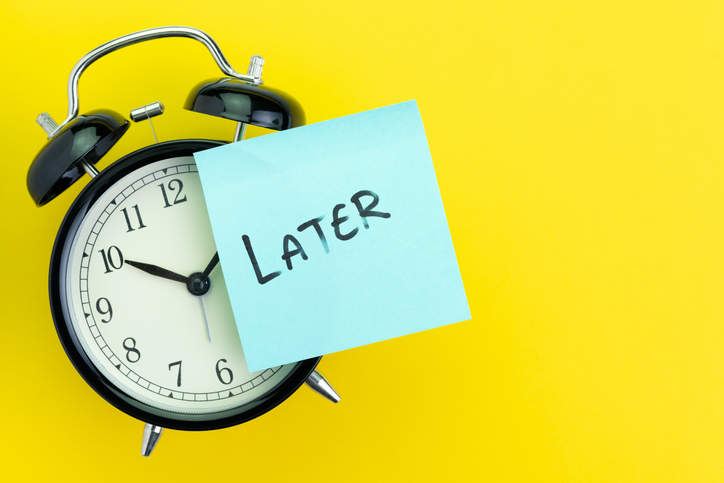
Productive procrastination is a delay tactic that feels good because you are getting other things done while avoiding the onerous or unpleasant ones. You keep yourself busy with something else and stay away from the big thing that’s really looming over your head. You still do things that need to be accomplished, but what you work on is less urgent and important than the items you push aside. This makes you feel temporarily better because you feel like you are making progress and you are. But this short term relief increases your long-term stress.
Productive procrastination and the ADHD brain
Reducing productive procrastination relies on self-regulation and the ability to prioritize. You have to do a brain dump: identify what’s critical to do right now (emergencies and crises), and then sort out everything else. This is where folks with ADHD stumble; it’s tough to determine what is most important if urgency isn’t attached to it.  It’s harder to write a history paper or finish that work report than it is to do the laundry. Both need to be accomplished, but doing the laundry is less cognitively demanding than writing, so it gets pushed to the front. It’s a task that’s more on autopilot than the creative, organizing, sorting and persistence needed for research and writing. That’s why ADHD brains wander off to do those tasks first. Tasks that lend themselves to productive procrastination often have a time frame, with clear starting and endpoints. Doing the laundry or taking out the chicken to defrost for dinner is a finite task. Written work, especially if you throw in perfectionism, does not. The ADHD brain, driven towards the satisfaction and engagement from tangible, higher dopamine activities (those that seem more easily achievable), will focus on those activities first.
It’s harder to write a history paper or finish that work report than it is to do the laundry. Both need to be accomplished, but doing the laundry is less cognitively demanding than writing, so it gets pushed to the front. It’s a task that’s more on autopilot than the creative, organizing, sorting and persistence needed for research and writing. That’s why ADHD brains wander off to do those tasks first. Tasks that lend themselves to productive procrastination often have a time frame, with clear starting and endpoints. Doing the laundry or taking out the chicken to defrost for dinner is a finite task. Written work, especially if you throw in perfectionism, does not. The ADHD brain, driven towards the satisfaction and engagement from tangible, higher dopamine activities (those that seem more easily achievable), will focus on those activities first.
4 tips to combat productive procrastination:
1. Break down big tasks into smaller chunks
When you complete a piece of work, the work not only then seems smaller, but it also helps reduce your anxiety about completing it. Create a fixed time period to work on it so it doesn’t takeover your life. If you are parenting a child or teen with ADHD, prepare to assist them in chunking assignments and chores. Take stock of what you’ve accomplished when you take your pause. You’ve done something, keep going!
2. Pay attention to and address mood issues
Your son may not want to walk the dog because he’s not in the mood. Your daughter may pick an argument with you to avoid doing her math homework. You may struggle yourself to summon up the effort to sit down and balance your checking account. Overcoming your negativity using emotional control, and starting anyway, is what’s called for. With a smaller chunk of work as your goal, and a set start and stop time, you may find that you can summon the motivation to begin. Consider playing soothing or inspirational music, making a cup of your favorite tea or setting your timer. Ask your kids what would help them get into the frame of mind. The mood may never arrive, and that’s okay. Do it anyway. If you can’t, make a plan with a friend, family member or work buddy to help you talk about what’s bothering and sit down at your desk. If there is nobody you can reach, talk it out in your voice memo, or write it out for a short timed period. Think about how you will feel (positively) on the other side of doing some work.
3. Avoid negative self-talk, exaggeration and trickery
Negative self-talk will tell you that you can’t do things that you actually can do and probably have accomplished in the past. Anxiety often erases memories of courage and competence, and our negative memory bias doesn’t help. Anxiety also distorts things and can exaggerate the discomfort or impossibility of doing a task. Many people with ADHD also deceive themselves into thinking they cannot do something because it didn’t work before, without giving themselves a chance to try it again differently. This is true for kids, too. Challenge these parts by recalling previous successes. Think about a time when you dreaded doing something and left it until the last minute.
-
- How did that work out for you?
- What was the price you paid to complete it?
- Do you want to do that again?
Create some phrases to talk back to this part of you:
-
- Say, “Yes, I can do this, and I have succeeded in the past.”
- Or, “I’ve set my timers, I’ve planned my reward when I stop, so let’s get started.”
4. Build a strategy to reduce productive procrastination
Use your logic and ask for help when needed. These tools will continue to improve prioritization skills. Over and over, ask yourself (or your child) about the time and value factors related to the tasks on your to-do list:
-
- Is this urgent?
- What is the importance of this task?
Identify helpful supports–whether digital apps or human advise. Create a map of how to approach the hard stuff, how to set up meaningful incentives, and what tools you might need for self-regulation to get there. If you are really struggling, consider finding a buddy who can assist you or keep you company in this process. 
Read more blog posts:
- Planning and Prioritizing Practices for ADHD Brains: What’s the plan, and when do you start?!
- ADHD and Motivation: How stress reduces productivity and what you can do about it
- Personal Project Planners for ADHD Minds: Start managing tasks, time and ideas with this creative tool!
Watch on Dr. Saline’s YouTube Channel:
- ADHD & Productive Procrastination (ADDitude ADHD Q&A with Dr. Sharon Saline)
- Planning and Prioritizing with ADHD (ADDitude ADHD Q&A with Dr. Sharon Saline)
- 4 Tips to Boost Motivation in Kids and Teens (WWLP 22 News Mass Appeal Interview with Dr. Sharon Saline)
Deeper dive: https://drsharonsaline.com/product/harness-grit/ https://drsharonsaline.com/product/home-seminar/
Sources: Ramsay, R. (2020, July 16). Procrastivity (a.k.a. sneaky avoidance) and adult ADHD coping. Psychology Today. Retrieved November 3, 2021, from https://www.psychologytoday.com/us/blog/rethinking-adult-adhd/202007/procrastivity-aka-sneaky-avoidance-and-adult-adhd-coping. Steel, P. (2012). The procrastination equation: How to stop putting things off and start getting stuff done. Harper.
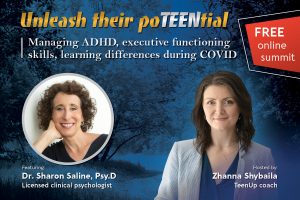 Hi there—
Hi there—
 In order for kids to learn how to plan and prioritize, they have to understand the difference between urgent and important. Something urgent is time-related and has to be dealt with immediately. There’s a deadline, a limit or an impending crisis such as preparing for a test tomorrow, writing a paper that’s due tomorrow or finishing your taxes on April 15th at 11:58 pm. Something important is value-driven. It matters but there is less pressure around it: the “right-away factor” is missing. Things like extra-credit projects, practicing the piano or exercising fall into this category. When a task is both urgent and important, it has to get done NOW. This is where we begin to help kids with ADHD: they’ve got to figure out how to do this since it’s just not clear to them. With their NOW/NOT NOW brains, it’s all or nothing. Many kids tell me that they can’t start anything without the fire of a deadline underneath and then they are incredibly stressed and anxious. While they may push back against any support you are offering, they, like you, want to argue less and feel proud of themselves. These are your motivators.
In order for kids to learn how to plan and prioritize, they have to understand the difference between urgent and important. Something urgent is time-related and has to be dealt with immediately. There’s a deadline, a limit or an impending crisis such as preparing for a test tomorrow, writing a paper that’s due tomorrow or finishing your taxes on April 15th at 11:58 pm. Something important is value-driven. It matters but there is less pressure around it: the “right-away factor” is missing. Things like extra-credit projects, practicing the piano or exercising fall into this category. When a task is both urgent and important, it has to get done NOW. This is where we begin to help kids with ADHD: they’ve got to figure out how to do this since it’s just not clear to them. With their NOW/NOT NOW brains, it’s all or nothing. Many kids tell me that they can’t start anything without the fire of a deadline underneath and then they are incredibly stressed and anxious. While they may push back against any support you are offering, they, like you, want to argue less and feel proud of themselves. These are your motivators. 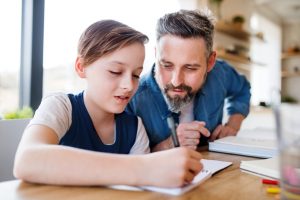 Armed with a paper calendar, markers, pens and Post-It notes, make a time to sit down with your son or daughter for no more than 20 minutes. Follow these steps to teach planning and prioritizing:
Armed with a paper calendar, markers, pens and Post-It notes, make a time to sit down with your son or daughter for no more than 20 minutes. Follow these steps to teach planning and prioritizing:  When you discuss how to order and evaluate tasks, teach planning strategies and work together to use calendars with steps for getting things done, you show your child with ADHD how to plan and prioritize with Collaboration and Consistency.
When you discuss how to order and evaluate tasks, teach planning strategies and work together to use calendars with steps for getting things done, you show your child with ADHD how to plan and prioritize with Collaboration and Consistency.  Family dinners are not only an important way to come together as a family but also a time to teach social skills. Eating together, no matter how briefly, offers a chance to pay attention to each other. You practice listening, making eye contact and the ritual of sharing food. The trick is how to do this with less conflict and more enjoyment. Dinner time needs to be a tech-free time. Instead of checking with your phones, check in with each other. Try the ritual of asking for a high and low from the day. This gives each person a chance to share something that went well and something that didn’t. To keep the focus positive, you can follow up on the high note with a related question. Or ask a specific question about a class, lunch or recess related to who they sat next to or played with. Try to avoid general questions such as “How was your day?” or discussing potentially upsetting topics such as homework. You can discuss these after the meal.
Family dinners are not only an important way to come together as a family but also a time to teach social skills. Eating together, no matter how briefly, offers a chance to pay attention to each other. You practice listening, making eye contact and the ritual of sharing food. The trick is how to do this with less conflict and more enjoyment. Dinner time needs to be a tech-free time. Instead of checking with your phones, check in with each other. Try the ritual of asking for a high and low from the day. This gives each person a chance to share something that went well and something that didn’t. To keep the focus positive, you can follow up on the high note with a related question. Or ask a specific question about a class, lunch or recess related to who they sat next to or played with. Try to avoid general questions such as “How was your day?” or discussing potentially upsetting topics such as homework. You can discuss these after the meal. 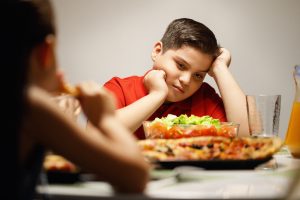 Many kids with ADHD have trouble sitting at the dinner table or even focusing on eating their food. If this is the case in your house, I’d recommend against turning on the television or iPad to distract them so they’ll eat and try these activities instead:listen to an engaging audio book, play a card game and offer small meals. Sometimes kids prefer grazing: eating a little bit, taking a break and coming back to the table. Work with your son or daughter to create a plan that makes sense to them and satisfies your goals of being sure they consume nutritious food. Bon Appetit!
Many kids with ADHD have trouble sitting at the dinner table or even focusing on eating their food. If this is the case in your house, I’d recommend against turning on the television or iPad to distract them so they’ll eat and try these activities instead:listen to an engaging audio book, play a card game and offer small meals. Sometimes kids prefer grazing: eating a little bit, taking a break and coming back to the table. Work with your son or daughter to create a plan that makes sense to them and satisfies your goals of being sure they consume nutritious food. Bon Appetit! 
 Anxiety is a physiological response related to a perceived danger and worried, negative thinking. Basic fight or flight responses are triggered from worries and these reactions are usually disproportionate to the concern at hand. Worry can be productive or poisonous. Productive worry is worry about doing things–completing homework or getting to work on time –and can be helpful in getting things done. Poisonous worry is worry about things you can’t control–the ultimate demise of the planet or whether people like you–and can be debilitating. The first step to dealing effectively with anxiety is to determine which type of worry you are dealing with. Then, engage the thinking brain to slow down the tidal wave of anxiety and emotion volcano by doing two things:
Anxiety is a physiological response related to a perceived danger and worried, negative thinking. Basic fight or flight responses are triggered from worries and these reactions are usually disproportionate to the concern at hand. Worry can be productive or poisonous. Productive worry is worry about doing things–completing homework or getting to work on time –and can be helpful in getting things done. Poisonous worry is worry about things you can’t control–the ultimate demise of the planet or whether people like you–and can be debilitating. The first step to dealing effectively with anxiety is to determine which type of worry you are dealing with. Then, engage the thinking brain to slow down the tidal wave of anxiety and emotion volcano by doing two things: 
 Most kids tend to stay away from the stuff that scares them. Who doesn’t? Anxiety is a powerful force to contend with. If they’re not exposed to it, then they’re not afraid. But avoidance and depending completely on you for comfort may feel good now but doesn’t help them in the long run. They don’t learn essential skills for self-soothing and positive self-talk. People build courage by being afraid and doing it anyway. Comfort is important to give but it can’t be the only solution.
Most kids tend to stay away from the stuff that scares them. Who doesn’t? Anxiety is a powerful force to contend with. If they’re not exposed to it, then they’re not afraid. But avoidance and depending completely on you for comfort may feel good now but doesn’t help them in the long run. They don’t learn essential skills for self-soothing and positive self-talk. People build courage by being afraid and doing it anyway. Comfort is important to give but it can’t be the only solution. 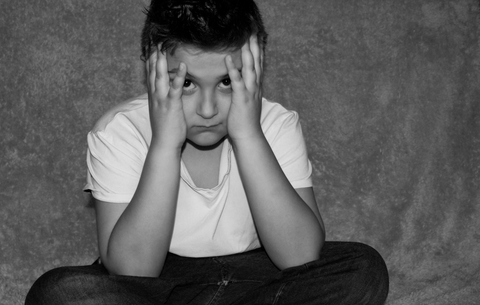 Learning to tolerate discomfort in the dark takes time. You will probably have to proceed slowly at first. Set up a plan by talking with your son or daughter about what frightens them, when they’ve managed to overcome that fear and how they did it. You want to identify successful nights and what made them work. Your child wants this to go away and so do you: that’s your mutual motivation for creating a collaborative plan. The goal is to strengthen the side of them that wants to do it and make it bigger than the part that doesn’t. Use incentives with your plan such as points towards an activity they like (playing a game with you, additional screen time, etc.).
Learning to tolerate discomfort in the dark takes time. You will probably have to proceed slowly at first. Set up a plan by talking with your son or daughter about what frightens them, when they’ve managed to overcome that fear and how they did it. You want to identify successful nights and what made them work. Your child wants this to go away and so do you: that’s your mutual motivation for creating a collaborative plan. The goal is to strengthen the side of them that wants to do it and make it bigger than the part that doesn’t. Use incentives with your plan such as points towards an activity they like (playing a game with you, additional screen time, etc.). 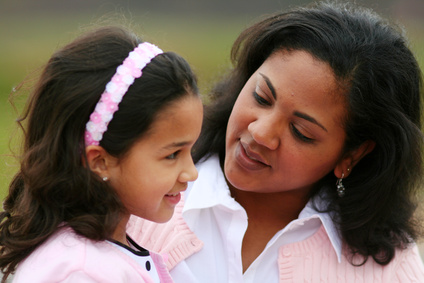 This may sound crazy but let’s take riding a roller coaster. Instead of going on the biggest one or even the medium-sized one, you start with something small to build your confidence. Then if that goes well, you can try a larger one. Similarly, leaving your child alone in the dark may be too much right now. Make a game to check the closet and under the bed for unwanted “guests.” When it’s time to turn out the light, turn on a night light, keep the door open, maybe play some soothing music and leave a light on in the hallway. Limit your time hanging out with them to ten minutes and discuss this well before bedtime. Maybe you’ll need to sit in a chair at first, then by the door while humming a favorite tune. When they’re doing a better job of managing the separation and falling asleep on their own, consider closing the door halfway. Maybe that’s enough. At some point, perhaps you can close the door completely and if you can’t that’s okay too. The goal is to start doing small changes, let them feel successful and then tackle the bigger stuff.
This may sound crazy but let’s take riding a roller coaster. Instead of going on the biggest one or even the medium-sized one, you start with something small to build your confidence. Then if that goes well, you can try a larger one. Similarly, leaving your child alone in the dark may be too much right now. Make a game to check the closet and under the bed for unwanted “guests.” When it’s time to turn out the light, turn on a night light, keep the door open, maybe play some soothing music and leave a light on in the hallway. Limit your time hanging out with them to ten minutes and discuss this well before bedtime. Maybe you’ll need to sit in a chair at first, then by the door while humming a favorite tune. When they’re doing a better job of managing the separation and falling asleep on their own, consider closing the door halfway. Maybe that’s enough. At some point, perhaps you can close the door completely and if you can’t that’s okay too. The goal is to start doing small changes, let them feel successful and then tackle the bigger stuff. 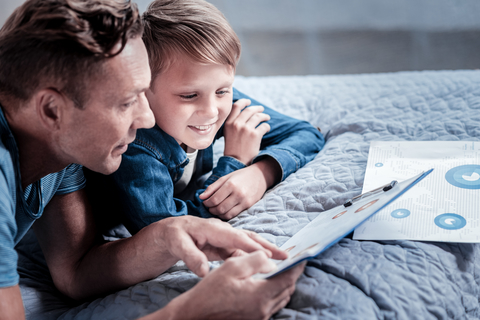 Be patient. Reducing night-time worries takes time, practice and some stumbling along the way. Stick with the plan you’ve both created for a few days, assess how it’s working together, and make any necessary adjustments. Let your child’s desire to do things differently guide you. Courage will naturally follow.
Be patient. Reducing night-time worries takes time, practice and some stumbling along the way. Stick with the plan you’ve both created for a few days, assess how it’s working together, and make any necessary adjustments. Let your child’s desire to do things differently guide you. Courage will naturally follow.